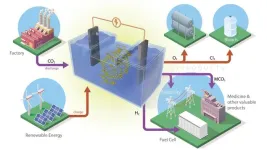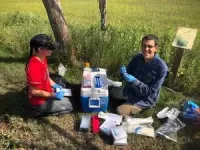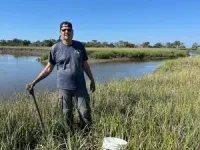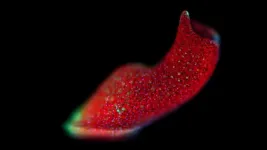(Press-News.org) Researchers at the Department of Energy’s Oak Ridge National Laboratory are developing battery technologies to fight climate change in two ways, by expanding the use of renewable energy and capturing airborne carbon dioxide.
This type of battery stores the renewable energy generated by solar panels or wind turbines. Utilizing this energy when wind and sunlight are unavailable requires an electrochemical reaction that, in ORNL’s new battery formulation, captures carbon dioxide from industrial emissions and converts it to value-added products.
ORNL researchers recently created and tested two different formulations for batteries that convert carbon dioxide gas, or CO2, into a solid form that has the potential to be used in other products.
One of these new battery types maintained its capacity for 600 hours of use and could store up to 10 hours of electricity. Researchers also identified, studied and overcame the primary challenge, a deactivation caused by chemical buildup, that had been an obstacle for the other battery formulation.
“The Transformation Energy Science and Technology, or TEST, initiative at ORNL is precisely the kind of effort needed to address climate change. We are excited that ORNL is investing in innovative ideas and approaches that can transform the way we think about storing energy beyond lithium-ion batteries and other conventional electrochemical energy storage systems,” said Ilias Belharouak, an ORNL Corporate Fellow and initiative director. “What a fantastic scenario: Using free electrons to store CO2 and converting it to revenue-generating products is a concept I never would have imagined 10 years back, but this is just a start.”
Batteries operate through electrochemical reactions that move ions between two electrodes through an electrolyte. Unlike cell phone or car batteries, those designed for grid energy storage do not have to function as a portable, closed system. This allowed ORNL researchers to create and test two types of batteries that could convert CO2 from stationary, industrial sources.
For example, CO2 generated by a power plant could be pumped through a tube into the liquid electrolyte, creating bubbles similar to those in a carbonated soft drink. During battery operation, the gas bubbles turn into a solid powder.
How it works
Each component of a battery can be made of different elements or compounds. These choices determine the battery’s operational lifetime, how much energy it can store, how big or heavy it is, and how fast it charges or consumes energy. Of the new ORNL battery formulations, one combines CO2 with sodium from saltwater using an inexpensive iron-nickel catalyst. The second combines the gas with aluminum.
Each approach uses abundant materials and a liquid electrolyte in the form of saltwater, sometimes mixed with other chemicals. The batteries are safer than existing technology because their electrodes are stable in water, said lead researcher Ruhul Amin.
Very little CO2 battery research has been conducted. The previously-tried approach relies on a reversible metal-CO2 reaction that regenerates carbon dioxide, continuing to contribute greenhouse gases to the atmosphere. In addition, solid discharge products tend to clog the surface of the electrode, degrading the battery performance.
However, the CO2 batteries developed at ORNL do not release carbon dioxide. Instead, the carbonate byproduct dissolves in the liquid electrolyte. The byproduct either continuously enriches the liquid to enhance battery performance, or it can be filtered from the bottom of the container without interrupting battery operation. Battery design can even be tuned to create more of these byproducts for use by the pharmaceutical or cement industries. The only gases released are oxygen and hydrogen, which do not contribute to climate change and can even be captured to produce energy or fuel.
ORNL researchers used an almost completely new combination of materials for these CO2 batteries. The few similar previous designs worked for only short periods or incorporated expensive metals.
Pros, cons and challenges overcome
The sodium-carbon dioxide, or Na-CO2, battery was developed first and faced some obstacles. For this system to function, the electrodes must be separated in wet and dry chambers with a solid ion conductor between them. The barrier slows the movement of ions, which in turn slows down battery operation, reducing battery efficiency.
One significant challenge for this Na-CO2 battery is that after prolonged use, a film forms on the electrode surface, which eventually causes the battery to deactivate. Amin’s research team used highly specialized microscopes and X-ray techniques to examine the battery cell when it failed and at various stages of operation.
Studying how the film formed helped researchers understand how to break it down again. They were intrigued to realize the battery could be reactivated, or prevented from deactivating at all, simply through operational changes in the charge/discharge cycle. Uneven pulses of charging and discharging prevented film buildup on the electrode.
“We are reporting for the first time that the deactivated cell can be reactivated,” Amin said. “And we found the origin of the deactivation and activation. If you symmetrically charge-discharge the battery too long, it’s dead at one stage. If you use the protocol we established for our cell, the chance of failure is very slim.”
A second design for long-term storage
Next, researchers focused on the design of the aluminum-carbon dioxide, or Al-CO2, battery. The team experimented with various electrolyte solutions and three different synthesis processes to identify the best combination. The result was a battery which provides enough storage for more than 10 hours of electricity to be used later.
“That’s huge for long-duration storage,” Amin said. “This is the first Al-CO2 battery that could run with stability for a long time, which is the goal. Holding just a few hours of stored energy doesn’t help.”
Testing found that the ORNL battery could operate more than 600 hours without losing capacity, Amin said – far more than the only previously reported Al-CO2 battery, which was only tested for eight hours of cycling.
The cherry on top is that this battery captures almost twice as much carbon dioxide as the Na-CO2 battery. It can be designed for the system to operate in a single chamber, with both electrodes in the same liquid solution, so there is no barrier to ion movement.
The challenge for the Al-CO2 battery is to bring it closer to scale-up, Amin said. Even so, the team will continue systematically studying its properties to extend the operating lifetime and capture CO2 more efficiently. For the Na-CO2 battery to be competitive, the team will focus on developing a very fine, dense, mechanically stable ceramic membrane to separate the battery chambers.
Other ORNL scientists who contributed to the project include Marm Dixit, Mengya Li, Sabine Neumayer, Yaocai Bai, Ilias Belharouak, Anuj Bisht, Yang Guang and former ORNL researcher Rachid Essehli. The research was funded through the ORNL Laboratory Directed Research and Development, or LDRD, program. The sodium-CO2 battery research utilized the Center for Nanophase Materials Sciences, a DOE user facility at ORNL.
UT-Battelle manages ORNL for the Department of Energy’s Office of Science, the single largest supporter of basic research in the physical sciences in the United States. The Office of Science is working to address some of the most pressing challenges of our time. For more information, please visit energy.gov/science.
END
Carbon-capture batteries developed to store renewable energy, help climate
2024-05-15
ELSE PRESS RELEASES FROM THIS DATE:
From roots to resilience: investigating the vital role of microbes in coastal plant health
2024-05-15
Georgia’s saltwater marshes — living where the land meets the ocean — stretch along the state’s entire 100-mile coastline. These rich ecosystems are largely dominated by just one plant: grass.
Known as cordgrass, the plant is an ecosystem engineer, providing habitats for wildlife, naturally cleaning water as it moves from inland to the sea, and holding the shoreline together so it doesn’t collapse. Cordgrass even protects human communities from tidal surges.
Understanding how these ...
Q&A: How did the COVID-19 pandemic affect older adults’ technology use?
2024-05-15
The onset of the COVID-19 pandemic changed how nearly everyone mediated their social interactions through technology. Some moved happy hours into video chats. Others delved deeper into social media, or took a step back from it. Millions of people worked or learned through computers.
University of Washington researchers took particular interest in how this tech shift affected older adults’ social relationships. The team interviewed 16 older adults in Washington and Oregon, ages 65 to 80, about how their technology ...
Blood pressure drugs more than double bone-fracture risk in nursing home patients
2024-05-15
Records from nearly 30,000 nursing home residents indicate that blood pressure medications more than double the risk of life-threatening bone fractures, according to Rutgers Health research.
The authors of the study, which appears in JAMA Internal Medicine, said the increased risk stems from the medications’ tendency to impair balance, particularly when patients first stand up and temporarily experience low blood pressure that deprives the brain of oxygen. Interactions with other drugs and low baseline balance in many nursing home patients compound the problem.
“Bone fractures often start nursing home patients on a downward spiral,” ...
Regenerating worms have genetic control over their algal partners
2024-05-15
Many organisms are far more complex than just a single species. Humans, for example, are full of a variety of microbes. Some creatures have even more special connections, though. Acoels, unique marine worms that regenerate their bodies after injury, can form symbiotic relationships with photosynthetic algae that live inside them. These collections of symbiotic organisms are called a holobiont, and the ways that they “talk” to each other are something scientists are trying to understand – especially ...
Pre- and post-surgical immunotherapy improves outcomes for patients with operable lung cancer
2024-05-15
Compared with pre-surgical (neoadjuvant) chemotherapy alone, adding perioperative immunotherapy – given before and after surgery – significantly improved event-free survival (EFS) in patients with resectable early-stage non-small cell lung cancer(NSCLC), according to researchers from The University of Texas MD Anderson Cancer Center.
Results from the Phase III CheckMate 77T study were published today in the New England Journal of Medicine. At a median follow-up of 25.4 months, the median EFS with chemotherapy alone was 18.4 months, while the median had not yet ...
'Trojan horse' weight loss drug more effective than available therapies
2024-05-15
“I consider the drugs available on the marked today as the first generation of weight-loss drugs. Now we have developed a new type of weight-loss drug that affects the plasticity of the brain and appears to be highly effective.”
So says Associate Professor and Group Leader Christoffer Clemmensen, from the Novo Nordisk Foundation Center for Basic Metabolic Research at the University of Copenhagen, who is senior author of the new study, which has been published in the prestigious scientific journal Nature.
In the study, Christoffer Clemmensen and colleagues demonstrate a new use of the weight loss hormone GLP-1. GLP-1 can be used as a ‘Trojan ...
Reduced risk of breast cancer following bariatric surgery in women with hyperinsulinemia
2024-05-15
Bariatric surgery is associated with a reduced risk of breast cancer in women with obesity. These are the findings of a study conducted at the University of Gothenburg. The risk reduction is greatest for those with high blood insulin levels at the time of surgery.
The study, published in JAMA Surgery, is based on data from 2,867 women with obesity, half of whom had undergone bariatric surgery at 25 surgical departments. The remaining women, comprising the control group, received standard obesity treatment at 480 healthcare centers. The groups were otherwise comparable in terms of age and body composition.
The results show that a total of ...
Copper can't be mined fast enough to electrify the US
2024-05-15
Copper cannot be mined quickly enough to keep up with current U.S. policy guidelines to transition the country's electricity and vehicle infrastructure to renewable energy, according to a University of Michigan study.
The Inflation Reduction Act, signed into law in 2022, calls for 100% of cars manufactured to be electric vehicles by 2035. But an electric vehicle requires three to five times as much copper as an internal combustion engine vehicle—not to mention the copper required for upgrades to the electric grid.
"A ...
Guideline issued for people with epilepsy who may become pregnant
2024-05-15
EMBARGOED FOR RELEASE UNTIL 4 P.M. ET, WEDNESDAY, MAY 15, 2024
MINNEAPOLIS – A new guideline has been issued to help neurologists and other clinicians determine the best antiseizure medications for people with epilepsy who may become pregnant. The guideline is published in the May 15, 2024, online issue of Neurology®, the medical journal of the American Academy of Neurology (AAN), and was developed through a collaboration between the AAN, the American Epilepsy Society (AES) and the Society for Maternal-Fetal Medicine (SMFM). It was endorsed by the Child Neurology Society.
The guideline partially updates two 2009 AAN and AES ...
Only 20% of U.S. nonprofit hospitals invested in housing as part of the federal community benefit mandate
2024-05-15
Waltham — May 15, 2024 — A nationwide assessment of how nonprofit hospitals are addressing housing-related needs in their communities appears in the latest issue of Medical Care, the official journal of the Medical Care Section of the American Public Health Association. The journal is published in the Lippincott portfolio by Wolters Kluwer.
"Approximately 60% of hospitals in the United States are 501(c)(3) nonprofit organizations ...






